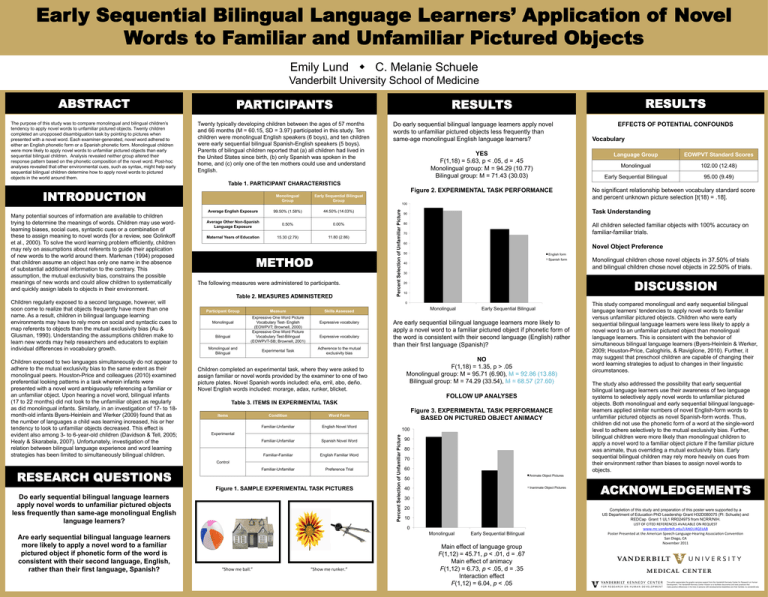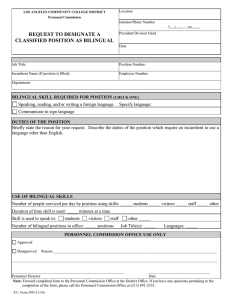Document 13199775
advertisement

Early Sequential Bilingual Language Learners’ Application of Novel Words to Familiar and Unfamiliar Pictured Objects Emily Lund w C. Melanie Schuele Vanderbilt University School of Medicine ABSTRACT PARTICIPANTS The purpose of this study was to compare monolingual and bilingual children’s tendency to apply novel words to unfamiliar pictured objects. Twenty children completed an unopposed disambiguation task by pointing to pictures when presented with a novel word. Each examiner-generated, novel word adhered to either an English phonetic form or a Spanish phonetic form. Monolingual children were more likely to apply novel words to unfamiliar pictured objects than early sequential bilingual children. Analysis revealed neither group altered their response pattern based on the phonetic composition of the novel word. Post-hoc analyses revealed that other environmental cues, such as syntax, might help early sequential bilingual children determine how to apply novel words to pictured objects in the world around them. Twenty typically developing children between the ages of 57 months and 66 months (M = 60.15, SD = 3.97) participated in this study. Ten children were monolingual English speakers (6 boys), and ten children were early sequential bilingual Spanish-English speakers (5 boys). Parents of bilingual children reported that (a) all children had lived in the United States since birth, (b) only Spanish was spoken in the home, and (c) only one of the ten mothers could use and understand English. Table 1. PARTICIPANT CHARACTERISTICS Children regularly exposed to a second language, however, will soon come to realize that objects frequently have more than one name. As a result, children in bilingual language learning environments may have to rely more on social and syntactic cues to map referents to objects than the mutual exclusivity bias (Au & Glusman, 1990). Understanding the assumptions children make to learn new words may help researchers and educators to explain individual differences in vocabulary growth. Children exposed to two languages simultaneously do not appear to adhere to the mutual exclusivity bias to the same extent as their monolingual peers. Houston-Price and colleagues (2010) examined preferential looking patterns in a task wherein infants were presented with a novel word ambiguously referencing a familiar or an unfamiliar object. Upon hearing a novel word, bilingual infants (17 to 22 months) did not look to the unfamiliar object as regularly as did monolingual infants. Similarly, in an investigation of 17- to 18month-old infants Byers-Heinlein and Werker (2009) found that as the number of languages a child was learning increased, his or her tendency to look to unfamiliar objects decreased. This effect is evident also among 3- to 6-year-old children (Davidson & Tell, 2005; Healy & Skarabela, 2007). Unfortunately, investigation of the relation between bilingual language experience and word learning strategies has been limited to simultaneously bilingual children. Early Sequential Bilingual Group Average English Exposure 99.50% (1.58%) 44.50% (14.03%) Average Other Non-Spanish Language Exposure 0.50% 0.00% Maternal Years of Education 11.80 (2.86) 15.30 (2.79) METHOD The following measures were administered to participants. Table 2. MEASURES ADMINISTERED YES F(1,18) = 5.63, p < .05, d = .45 Monolingual group: M = 94.29 (10.77) Bilingual group: M = 71.43 (30.03) Figure 2. EXPERIMENTAL TASK PERFORMANCE Monolingual Bilingual Measure Expressive One Word Picture Vocabulary Test- English (EOWPVT; Brownell, 2000) Expressive One Word Picture Vocabulary Test-Bilingual (EOWPVT-SB; Brownell, 2001) Monolingual and Bilingual Experimental Task Expressive vocabulary Adherence to the mutual exclusivity bias 70 60 50 Spanish form 40 Familiar-Unfamiliar English Novel Word Familiar-Unfamiliar Spanish Novel Word Experimental Familiar-Familiar English Familiar Word Familiar-Unfamiliar Preference Trial Control RESEARCH QUESTIONS Figure 1. SAMPLE EXPERIMENTAL TASK PICTURES Do early sequential bilingual language learners apply novel words to unfamiliar pictured objects less frequently than same-age monolingual English language learners? 10 Early Sequential Bilingual Are early sequential bilingual language learners more likely to apply a novel word to a familiar pictured object if phonetic form of the word is consistent with their second language (English) rather than their first language (Spanish)? NO F(1,18) = 1.35, p > .05 Monolingual group: M = 95.71 (6.90), M = 92.86 (13.88) Bilingual group: M = 74.29 (33.54), M = 68.57 (27.60) Figure 3. EXPERIMENTAL TASK PERFORMANCE BASED ON PICTURED OBJECT ANIMACY 100 90 80 70 60 “Show me runker.” 95.00 (9.49) No significant relationship between vocabulary standard score and percent unknown picture selection [t(18) = .18]. Monolingual children chose novel objects in 37.50% of trials and bilingual children chose novel objects in 22.50% of trials. This study compared monolingual and early sequential bilingual language learners’ tendencies to apply novel words to familiar versus unfamiliar pictured objects. Children who were early sequential bilingual language learners were less likely to apply a novel word to an unfamiliar pictured object than monolingual language learners. This is consistent with the behavior of simultaneous bilingual language learners (Byers-Heinlein & Werker, 2009; Houston-Price, Caloghiris, & Raviglione, 2010). Further, it may suggest that preschool children are capable of changing their word learning strategies to adjust to changes in their linguistic circumstances. The study also addressed the possibility that early sequential bilingual language learners use their awareness of two language systems to selectively apply novel words to unfamiliar pictured objects. Both monolingual and early sequential bilingual languagelearners applied similar numbers of novel English-form words to unfamiliar pictured objects as novel Spanish-form words. Thus, children did not use the phonetic form of a word at the single-word level to adhere selectively to the mutual exclusivity bias. Further, bilingual children were more likely than monolingual children to apply a novel word to a familiar object picture if the familiar picture was animate, thus overriding a mutual exclusivity bias. Early sequential bilingual children may rely more heavily on cues from their environment rather than biases to assign novel words to objects. Animate Object Pictures 50 40 Inanimate Object Pictures 30 20 10 Monolingual “Show me ball.” Early Sequential Bilingual DISCUSSION 20 0 Are early sequential bilingual language learners more likely to apply a novel word to a familiar pictured object if phonetic form of the word is consistent with their second language, English, rather than their first language, Spanish? 102.00 (12.48) 30 Table 3. ITEMS IN EXPERIMENTAL TASK Word Form Monolingual English form FOLLOW UP ANALYSES Condition EOWPVT Standard Scores Novel Object Preference Monolingual Children completed an experimental task, where they were asked to assign familiar or novel words provided by the examiner to one of two picture plates. Novel Spanish words included: eña, erril, abo, deño. Novel English words included: morarge, adax, runker, blicket. Items Language Group All children selected familiar objects with 100% accuracy on familiar-familiar trials. 80 Skills Assessed Expressive vocabulary Vocabulary Task Understanding 90 0 Participant Group EFFECTS OF POTENTIAL CONFOUNDS 100 Percent Selection of Unfamiliar Picture Many potential sources of information are available to children trying to determine the meanings of words. Children may use wordlearning biases, social cues, syntactic cues or a combination of these to assign meaning to novel words (for a review, see Golinkoff et al., 2000). To solve the word learning problem efficiently, children may rely on assumptions about referents to guide their application of new words to the world around them. Markman (1994) proposed that children assume an object has only one name in the absence of substantial additional information to the contrary. This assumption, the mutual exclusivity bias, constrains the possible meanings of new words and could allow children to systematically and quickly assign labels to objects in their environment. Monolingual Group Do early sequential bilingual language learners apply novel words to unfamiliar pictured objects less frequently than same-age monolingual English language learners? Percent Selection of Unfamiliar Picture INTRODUCTION RESULTS RESULTS Early Sequential Bilingual Main effect of language group F(1,12) = 45.71, p < .01, d = .67 Main effect of animacy F(1,12) = 6.73, p < .05, d = .35 Interaction effect F(1,12) = 6.04, p < .05 ACKNOWLEDGEMENTS Completion of this study and preparation of this poster were supported by a US Department of Education PhD Leadership Grant H32D080075 (PI: Schuele) and REDCap Grant 1 UL1 RR024975 from NCRR/NIH. LIST OF CITED REFERENCES AVAILABLE ON REQUEST www.mc.vanderbilt.edu/LANGUAGELAB Poster Presented at the American Speech-­‐Language-­‐Hearing AssociaKon ConvenKon San Diego, CA November 2011



